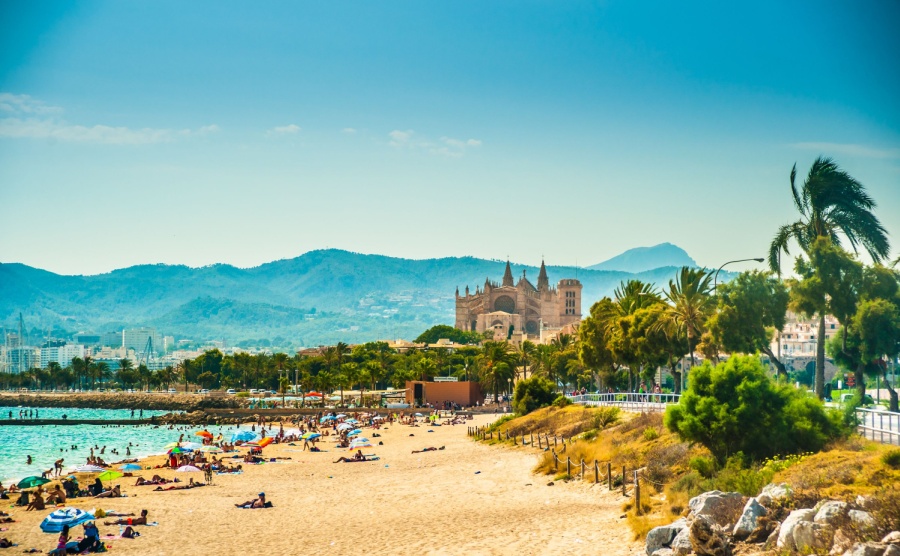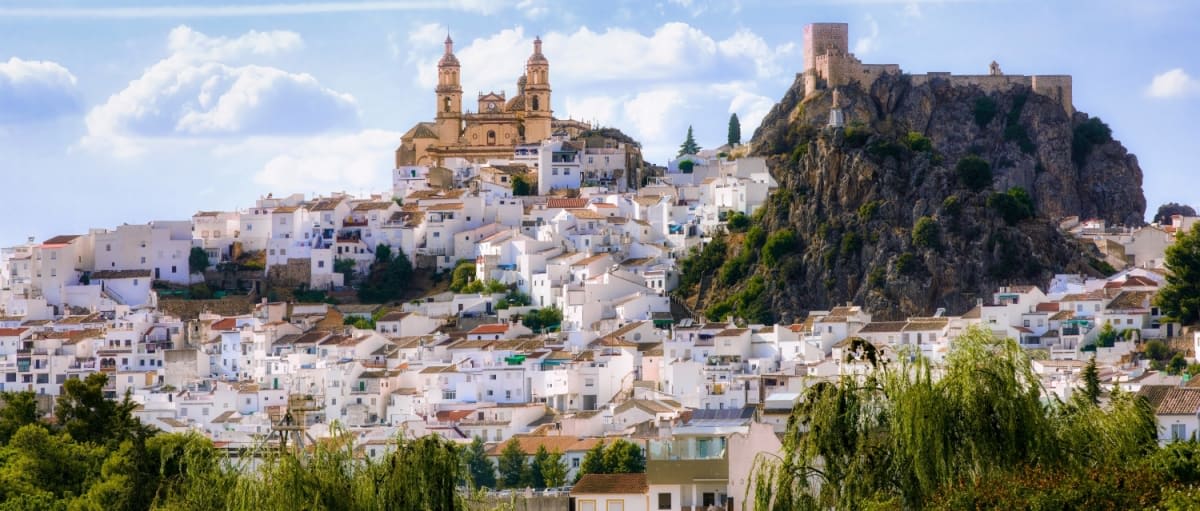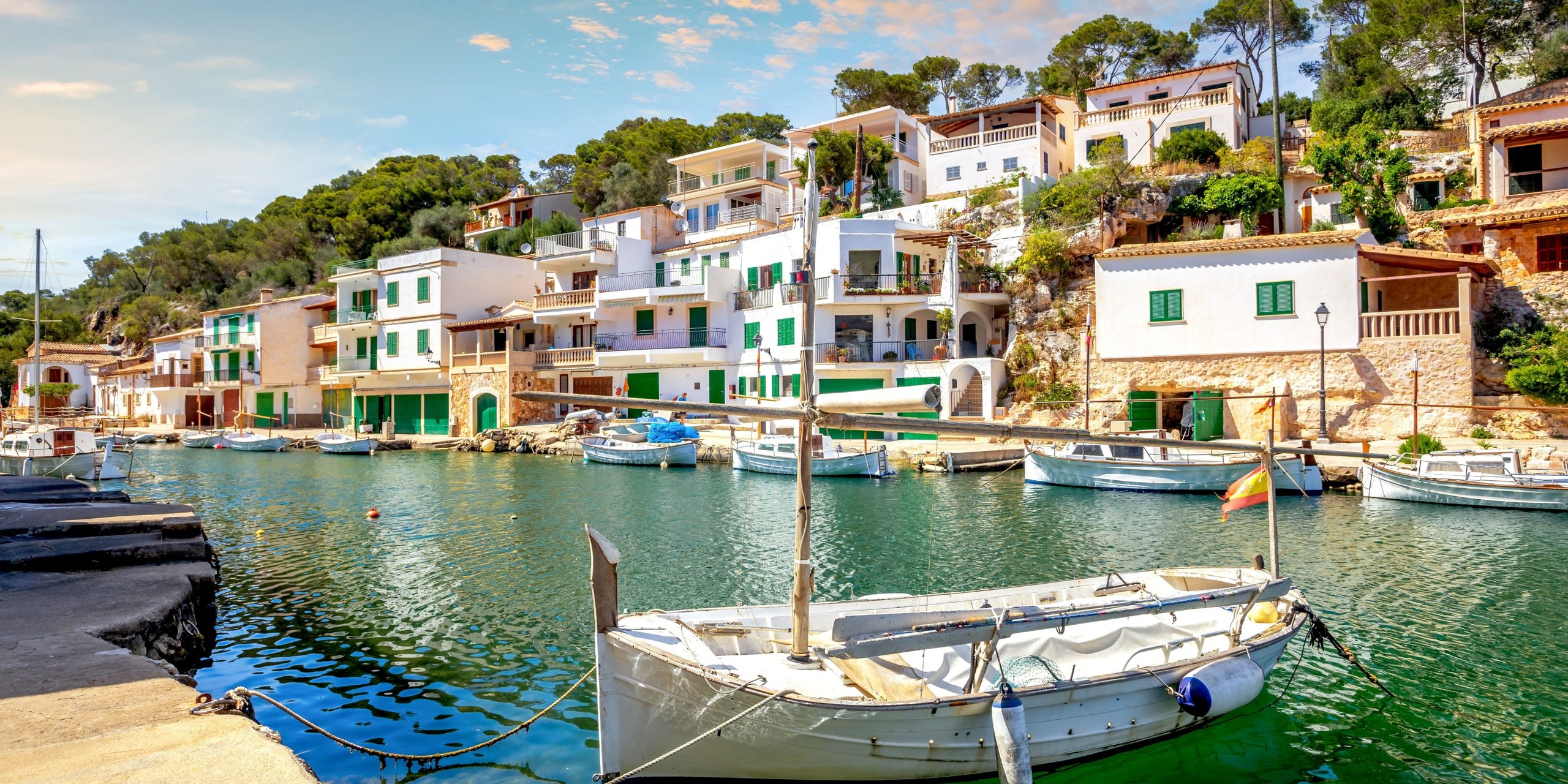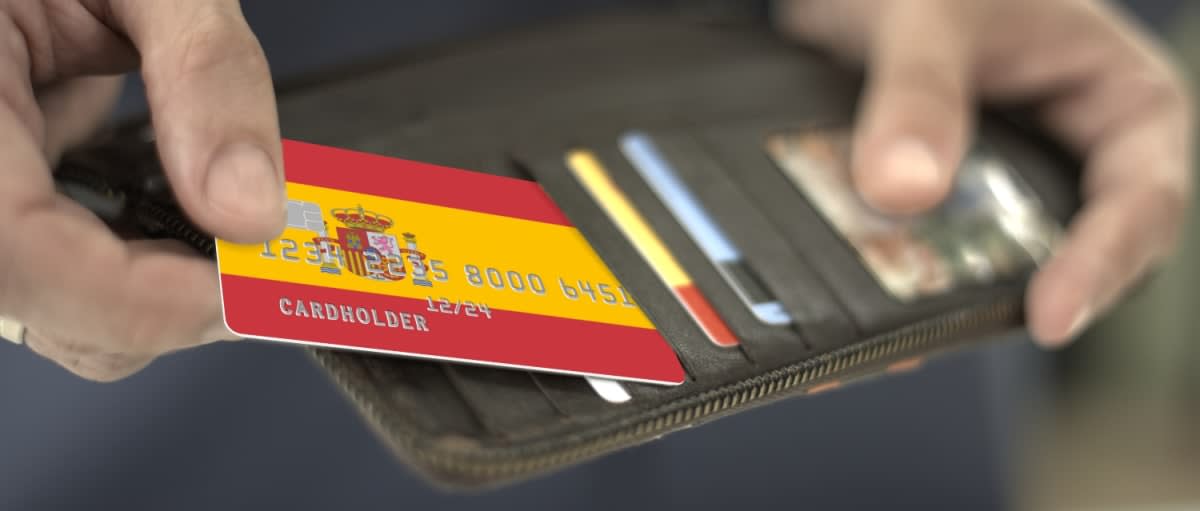Mallorca remains one of the most desirable locations in Spain for overseas buyers. Indeed, not just the most desirable in Spain. Mallorca – also known as Majorca – is probably the most visited island in the whole Mediterranean. Here’s your guide to buying property in Mallorca.
With its Mediterranean lifestyle, strong property market and broad range of locations, it continues to attract British and American buyers looking for a holiday home, retirement, relocation or long-term investment.
This guide explores what you need to know if you’re considering buying a property on the island in 2025, from local market trends to the practicalities of purchasing.
Download the Spain Buying Guide
Contents
About Mallorca
Mallorca is the largest of the Balearic Islands and offers a wide variety of settings for property buyers.
But it’s not large as islands go, and from landing at the main airport in Palma you can reach just about anywhere in about an hour by car or bus.
The island has a mountainous northern coast, then a flat interior full of farms, vineyards and villages. It’s 550-kilometre coast has, apartment from the north-west section of cliffs, mainly sandy beaches, with some historic towns and many modern resorts.

Mallorca has been popular among international property buyers for at least 509 years, giving buyers access to English-speaking professionals and a relatively straightforward buying process.
Though tourism plays a key role in the local economy, Mallorca is more than a seasonal destination. Many towns and villages maintain a strong sense of identity and community year-round, making it appealing to those looking for more than just a holiday home.
Is Mallorca a good place to buy property?
Mallorca combines natural beauty with well-developed infrastructure. The island has one of Spain’s busiest international airports, excellent healthcare, English-speaking professionals and good international schools. Unlike some tourist destinations, Mallorca also has a year-round community, particularly in and around Palma, which gives it a sense of continuity and liveability beyond the summer season.
From an investment point of view, Mallorca’s popularity ensures ongoing demand for rental properties and resale potential. But the authorities in Mallorca are well aware of the special place that it is, and strong planning restrictions protect the coastline and highlights from overdevelopment. This also helps support property values for those buying property in Mallorca for the long term.
Where do most expats live in Mallorca?
The expatriate population is spread across the island, with different areas appealing to different buyer profiles.
Palma, with a population of 400,000 is the capital and the centre of Mallorquin life. It offers a mix of historic properties, especially in the Moorish old town of cobbled alleyways, but also modern flats, attractive townhouses in areas like Santa Catalina, and villas on the hilly suburbs. They all have access to beaches, nightlife and wonderful art and culture. The city has a strong year-round community and good public transport connections.
Goring clockwise from Palma, in the far western corner of Mallorca, areas like Santa Ponsa, Portals Nous and Andratx are popular with British and international buyers. They offer higher-end homes close to marinas, golf courses and international schools.

On the mountainous north-west coast are the pretty, historic, arty towns like Deia, Soller and Valldemossa. These lead on to the north, with towns like Pollença and Alcúdia appealing to buyers looking for a quieter pace of life and more traditional surroundings.
The central plains offer farmhouses and fincas to buy in Mallorca, many of which have been restored beautifully. The smaller towns here, such as Sineu and Manacor, offer a cheaper Mallorcan property option.
The south-east coast has beaches thronged with happy tourists – mainly families – in summer, notably in Cala d’Or (“beach of gold”) or Porto Cristo. They get quieter in winter, inevitably, but you should still find a lively community here.
Mallorca property market trends
Property prices in the Balearics rose more than in any other Spanish region. This growth has been led by demand in the luxury segment, where sea views and outdoor space remain top priorities for international buyers.
According to recent figures, here are the average property prices per square metre in selected areas of Mallorca in 2024:
| Location | Average price per square metre |
|---|---|
| Palma | €4,442 |
| Santa Ponsa | €6,517 |
| Port Andratx | €8,991 |
| Alcúdia | €4,273 |
| Llucmajor | €3,778 |
| Son Vida | €8,229 |
| Manacor | €2,931 |
| Portals Nous – Bendinat | €8,412 |
| Cala Vinyes | €6,224 |
| S’Arenal – Son Verí | €3,664 |
| Calvià | €5,538 |
| Valldemossa | €3,887 |
| Sa Ràpita | €5,308 |
| Felanitx | €1,965 |
| Binissalem | €2,462 |
In popular areas such as Son Vida, Santa Ponsa and Port Andratx, prices are at their highest. But Palma is a large city of 400,000 people, and there are certainly much more expensive areas than the €4,500 or so per square metre and – by definition – many cheaper too.
How does buying property in Mallorca compare to the rest of Spain? The average is Barcelona is also €4,500, with prime areas at €7,200-plus. Palma compares well with a city such as Seville, at €3,300 even for the most expensive areas.
Buyers can still find better value in inland towns or on the eastern coast. The strength of the market reflects Mallorca’s consistent appeal to both lifestyle and investment buyers.
Search homes for sale in Spain
The climate in Mallorca
The island is fairly north in the Mediterranean, on a level with the city of Valencia, but the influence of the sea keeps winters mild. You will occasionally get a bit of frost, but generally you’ll be enjoying winter weather plenty warm enough for a round of golf (and possibly even a swim, depending on how hardy you are).
The rest of the year you can expect hot summers and dazzling springtimes, with total average sunshine around 2,750 hours per year.
Getting to Mallorca
Palma airport is one of Spain’s busiest, with frequent year-round flights to and from the UK, as well as connections to major European cities. Travelling from further afield is easy too, with direct transatlantic routes to Madrid or Barcelona and then a short transfer.
For those travelling by sea, ferries run regularly between Mallorca and mainland Spain, including services from Barcelona, Valencia and Dénia.
How to buy property in Mallorca
The first step is usually finding a local estate agent who understands the needs of overseas buyers. Agents can advise on suitable areas and help manage viewings.
Before making a formal offer, you’ll need to obtain a NIE (foreigner’s identification number) and open a Spanish bank account. This allows you to pay deposits and complete the transaction.
A local lawyer is essential to review contracts, check legal ownership, verify that the property is free from debts, and handle communication with the seller.
Speak to a Spain property expert
After agreeing the price, you will usually sign a reservation agreement, followed by a private purchase contract. Completion takes place at the notary, after which the property is registered in your name with the Land Registry.

Frequently asked questions about buying property in Mallorca
Yes. Foreigners, including non-EU citizens, can legally buy property in Mallorca. The process is straightforward, though you will need a NIE (foreigner’s identification number) and a Spanish bank account to complete the purchase. Many English-speaking lawyers and agents are available to guide you through the steps.
Mallorca remains one of Spain’s strongest property markets. Its combination of lifestyle, accessibility and planning restrictions makes it attractive both for long-term living and investment. Demand for holiday rentals is strong, especially in Palma, Port Andratx and Santa Ponsa, which helps support property values over time.
Since Brexit, British buyers are treated as non-EU nationals. You can still purchase property in Mallorca without restrictions, but you’ll need to comply with the 90/180-day rule for stays unless you apply for residency.
Sources









